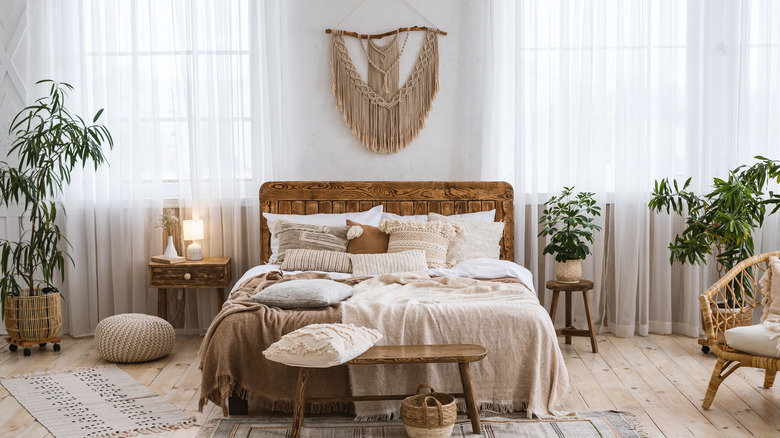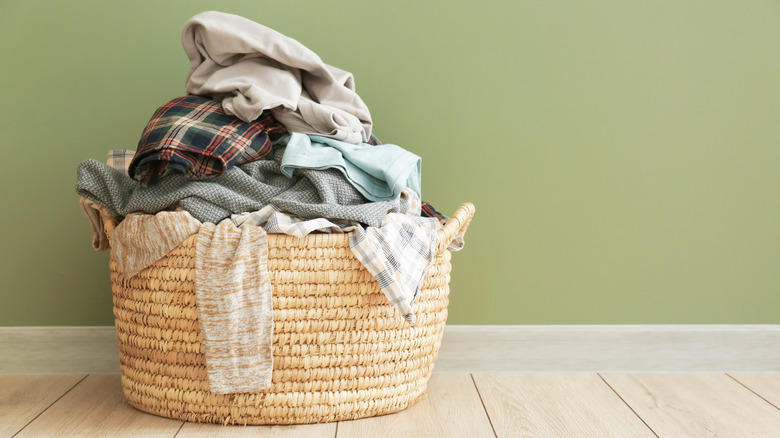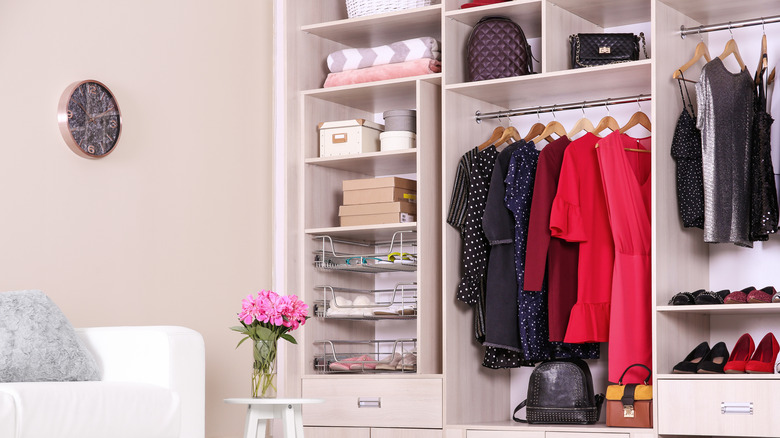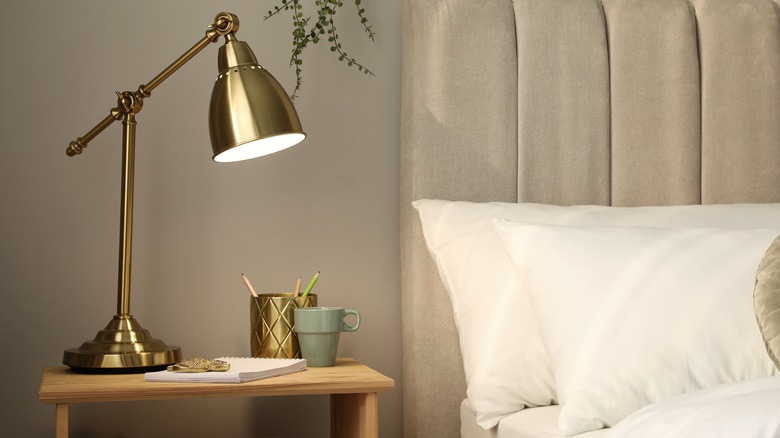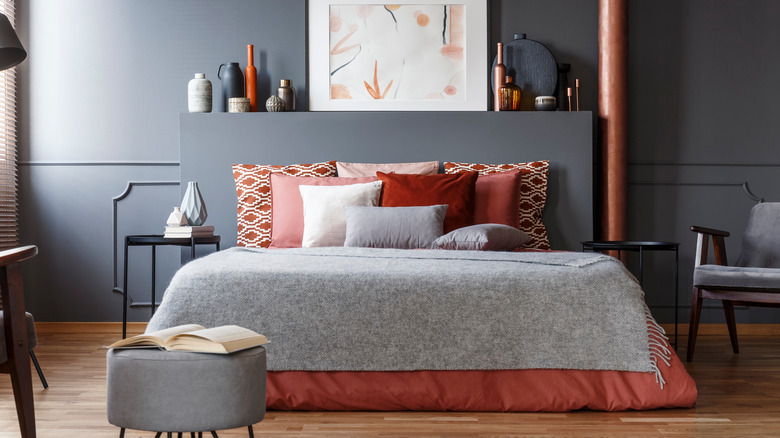5 Things That Are Making Your Bedroom Look Messy
Every room in your home serves a particular purpose. The same goes for all the items in each room, including the place you sleep. Sleep Health Group says your bedroom is for sleeping and intimacy, nothing else. It's your personal space to unwind and relax after a long day at work. So, if you're about to climb into bed for an early bedtime, how relaxed can you be if a giant pile of laundry takes up a good portion of your mattress? Can you have a chill evening if you first have to rearrange all 10 pillows? Once you've gotten under the covers and turned off the lamp, does the blinking light from your docked Roomba help lull you into a deep, restful sleep?
According to StudyFinds, four out of five Americans admit that they have at least one room that is always disorganized. Unfortunately for some, it might just be the room that should always take priority when it comes to clutter: your bedroom. Organizing Interiors also warns that having a cluttered bedroom will not bring you calm; in truth, it can cause anxiety. Luckily, we've found some of the most common clutter magnets in the bedroom, and they're also pretty easy to manage.
1. Laundry
It doesn't matter if your clothes are dirty, clean, or freshly laundered; they must always be in their respective homes. Dirty laundry goes in the hamper, and clean or freshly washed clothes should be immediately put away. Although you might not think it, unfolded laundry in any form is considered clutter, writes Home Storage Solutions 101. This is because it takes too much time and energy to sift through piles of clothes instead of folding and putting them away as soon as they're dry.
Mama's Laundry Talk notes that one of the best ways to conquer your bedroom clothing crag is by making (and sticking to) a laundry plan. In a nutshell, create a plan, make sure everyone in your family unit knows and follows it, donate anything you don't wear, and make sure your clothes don't land on a flat surface. This genius life hack also blends into other clutter-taming methods.
2. Open clothing storage
A trend born out of necessity, the open wardrobe is one of those essentially timeless décor trends, notes She Interiors. This type of storage will never go out of style as long as small homes and apartments exist. However, this storage system also means that your clothing, shoes, and other personal belongings are at least partially on display. Keeping your wardrobe orderly might be a bit challenging if you're already having trouble putting your laundry away. But you can do it!
One of the most important things to remember is that you want your open closet to look and be functional. Clothing can look like a chaotic mess, and Storage Café says that an excellent way to keep things looking clean is to declutter first. Keep what you actually wear and donate the rest to a local shelter or thrift store. Organizing by season, formality, or color is also a great way to keep your open wardrobe aesthetically pleasing. Don't be afraid to use the space above and below your other items. Lastly, keep in mind that certain fabrics and clothing items won't work on hangers, writes Martha Stewart.
3. Distracting electronics and equipment
While it's all personal preference, science dictates that technology is non-negotiable regarding what stays in your bedroom, via Sleep Foundation. Technology can refer to more than just tablets, computers, cell phones, and e-readers; it also includes TVs and exercise equipment. While it might be nice to lay in bed and binge-watch your favorite Netflix show before you go to bed, it's not healthy for your body. According to Everyday Health, the blue light from devices disrupts your circadian rhythms and lowers melatonin levels. TVs and larger furniture, like exercise bikes, also take up quite a bit of bedroom real estate, and there's no way to disguise them.
While you might not have complete control over it, Mattress Clarity states that your bedroom should not double as your office. This is because you're supposed to associate rest with your sleeping space, not productivity and alertness. Having a bedroom doubling as a workspace confuses your brain and makes your sleeping and efficiency levels suffer. Your bedroom is supposed to be a place to unwind and forget all the chaos of the day, so don't go inviting it in there on purpose.
4. Cluttered surfaces and walls
It's far too easy for spaces like bookshelves, nightstands, and the tops of dressers to suddenly transform into a pit stop for random baubles. These objects typically find their way to a flat surface when you're tired or are in the middle of putting them away but get sidetracked by other things on your to-do list. When sorting through tiny trinket piles, Marie Kondo reminds us that one of the essential clutter-busting tips for small objects is to give them a home. Like you, these little knick-knacks need a safe, secure resting place.
Too much stuff on your walls or little piles of anything will make your bedroom feel heavy and overwhelming instead of relaxing and calming. Overdecorating can invite the clutter monster into your relaxing abode. Sometimes, too many books or bookshelves can prevent you from getting a good night's sleep, according to Open Source Feng Shui. Seriously contrasting patterns or furniture will make your room feel anything but relaxing, via MyDomaine. That's why it's essential to keep things clutter-free and complimentary so that you can let out a sigh of relief and not despair when you enter your bedroom.
5. Too many pillows
A few household items somehow multiply without you realizing it — in the kitchen, it's the mugs, and in the bedroom, you can count on it being pillows. Blankets multiply like gremlins, too. While it seems like it's only natural to share your bed with one or two main pillow squeezes, with a few nestled in for supporting roles, the mattress mogul Casper states that there is such a thing as too many. An overabundance of pillows gives the appearance that there's too much going on and nowhere to sleep. It can also do damage to your spinal alignment instead of helping it, via Yahoo.
According to Home Decor Bliss, the required number of pillows changes based on the size of your mattress, So if you feel the absolute need to have at least eight pillows on your queen or double, it's, unfortunately, time to let some of those fluffy bed nuggets go. Or, you could buy a king mattress because eight is the maximum number of pillows for that size. Your mattress-to-pillow ratio should allow you to sleep comfortably. Remember that you're supposed to sleep in a bed, not share it with a bunch of pillows. Unless you're trying to build your own version of an adult pillow fort, then, by all means, go forth and build.
